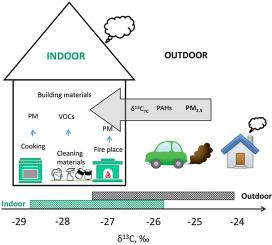当前位置:
X-MOL 学术
›
Atmos. Environ.
›
论文详情
Our official English website, www.x-mol.net, welcomes your
feedback! (Note: you will need to create a separate account there.)
Identification of wintertime carbonaceous fine particulate matter (PM2.5) sources in Kaunas, Lithuania using polycyclic aromatic hydrocarbons and stable carbon isotope analysis
Atmospheric Environment ( IF 4.2 ) Pub Date : 2020-09-01 , DOI: 10.1016/j.atmosenv.2020.117673 I. Garbarienė , A. Garbaras , A. Masalaite , D. Ceburnis , E. Krugly , V. Kauneliene , V. Remeikis , D. Martuzevicius
Atmospheric Environment ( IF 4.2 ) Pub Date : 2020-09-01 , DOI: 10.1016/j.atmosenv.2020.117673 I. Garbarienė , A. Garbaras , A. Masalaite , D. Ceburnis , E. Krugly , V. Kauneliene , V. Remeikis , D. Martuzevicius

|
Abstract The study aimed at demonstrating the application of PAHs and δ13C indoor and outdoor measurements towards resolving airborne carbonaceous particle sources in wintertime. Concurrent outdoor and indoor measurements of PM2.5 and size-resolved (PM0.056-2.5) particulate matter were conducted at 6 one-family houses in Kaunas, Lithuania during January–March 2013. PM2.5 and size-resolved filter samples were analyzed for total carbon (TC) and stable carbon isotopic composition by elemental analyzer connected to isotope ratio mass spectrometer. Moreover, the indoor-outdoor concentrations of 10 selected polycyclic aromatic hydrocarbons (PAHs) in PM2.5 were quantified. The simultaneous stable carbon isotope ratio and PAHs diagnostic ratio analysis enabled to identify main anthropogenic sources (traffic, biomass burning, and coal combustion) of PM2.5. Our study indicated that during winter period outdoor PM2.5 in Kaunas were mainly derived from biomass burning (solid fuel stoves) and vehicular emissions. Whereas indoor particulate matter had different stable carbon isotope composition of TC indicating the existence of pollution sources which was likely cooking emissions. The differences of indoor/outdoor stable carbon isotope composition in PM2.5 and size-resolved aerosol particles supported the existence of distinct TC sources and suggested that cooking emissions inside the house could strongly affect δ13C values.
中文翻译:

使用多环芳烃和稳定碳同位素分析鉴定立陶宛考纳斯冬季碳质细颗粒物 (PM2.5) 来源
摘要 本研究旨在展示 PAHs 和 δ13C 室内外测量在解决冬季空气中碳质粒子源方面的应用。2013 年 1 月至 3 月期间,在立陶宛考纳斯的 6 个独户住宅同时进行了 PM2.5 和尺寸分辨 (PM0.056-2.5) 颗粒物的室外和室内测量。 PM2.5 和尺寸分辨过滤器样本通过与同位素比质谱仪相连的元素分析仪分析总碳 (TC) 和稳定的碳同位素组成。此外,量化了 PM2.5 中 10 种选定的多环芳烃 (PAH) 的室内外浓度。同时进行的稳定碳同位素比和 PAH 诊断比分析能够确定 PM2.5 的主要人为来源(交通、生物质燃烧和煤炭燃烧)。我们的研究表明,考纳斯冬季室外 PM2.5 主要来自生物质燃烧(固体燃料炉)和车辆排放。而室内颗粒物具有不同的 TC 稳定碳同位素组成,表明存在可能是烹饪排放的污染源。PM2.5 和尺寸分辨气溶胶粒子的室内/室外稳定碳同位素组成的差异支持了不同 TC 源的存在,并表明房屋内的烹饪排放会强烈影响 δ13C 值。而室内颗粒物具有不同的 TC 稳定碳同位素组成,表明存在可能是烹饪排放的污染源。PM2.5 和尺寸分辨气溶胶粒子的室内/室外稳定碳同位素组成的差异支持了不同 TC 源的存在,并表明房屋内的烹饪排放会强烈影响 δ13C 值。而室内颗粒物具有不同的 TC 稳定碳同位素组成,表明存在可能是烹饪排放的污染源。PM2.5 和尺寸分辨气溶胶粒子的室内/室外稳定碳同位素组成的差异支持了不同 TC 源的存在,并表明房屋内的烹饪排放会强烈影响 δ13C 值。
更新日期:2020-09-01
中文翻译:

使用多环芳烃和稳定碳同位素分析鉴定立陶宛考纳斯冬季碳质细颗粒物 (PM2.5) 来源
摘要 本研究旨在展示 PAHs 和 δ13C 室内外测量在解决冬季空气中碳质粒子源方面的应用。2013 年 1 月至 3 月期间,在立陶宛考纳斯的 6 个独户住宅同时进行了 PM2.5 和尺寸分辨 (PM0.056-2.5) 颗粒物的室外和室内测量。 PM2.5 和尺寸分辨过滤器样本通过与同位素比质谱仪相连的元素分析仪分析总碳 (TC) 和稳定的碳同位素组成。此外,量化了 PM2.5 中 10 种选定的多环芳烃 (PAH) 的室内外浓度。同时进行的稳定碳同位素比和 PAH 诊断比分析能够确定 PM2.5 的主要人为来源(交通、生物质燃烧和煤炭燃烧)。我们的研究表明,考纳斯冬季室外 PM2.5 主要来自生物质燃烧(固体燃料炉)和车辆排放。而室内颗粒物具有不同的 TC 稳定碳同位素组成,表明存在可能是烹饪排放的污染源。PM2.5 和尺寸分辨气溶胶粒子的室内/室外稳定碳同位素组成的差异支持了不同 TC 源的存在,并表明房屋内的烹饪排放会强烈影响 δ13C 值。而室内颗粒物具有不同的 TC 稳定碳同位素组成,表明存在可能是烹饪排放的污染源。PM2.5 和尺寸分辨气溶胶粒子的室内/室外稳定碳同位素组成的差异支持了不同 TC 源的存在,并表明房屋内的烹饪排放会强烈影响 δ13C 值。而室内颗粒物具有不同的 TC 稳定碳同位素组成,表明存在可能是烹饪排放的污染源。PM2.5 和尺寸分辨气溶胶粒子的室内/室外稳定碳同位素组成的差异支持了不同 TC 源的存在,并表明房屋内的烹饪排放会强烈影响 δ13C 值。










































 京公网安备 11010802027423号
京公网安备 11010802027423号